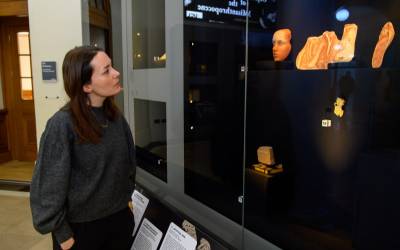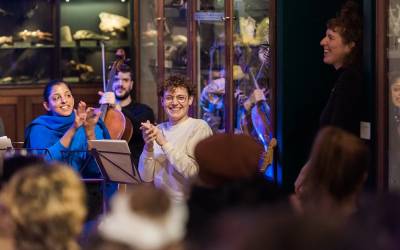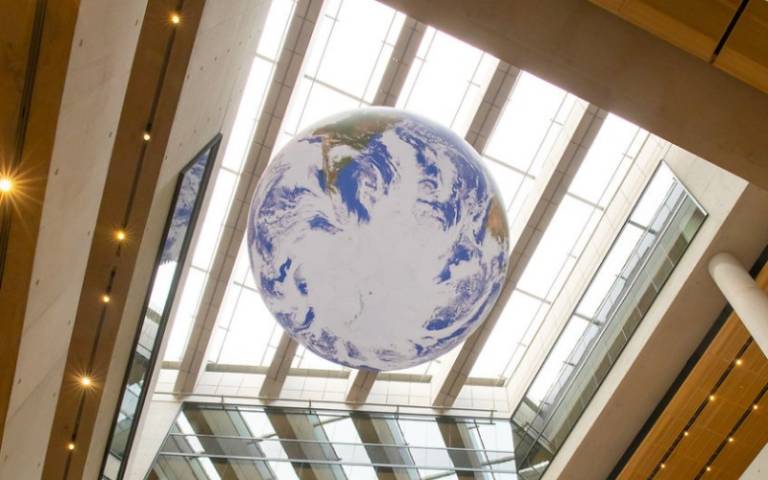LCCOS has had global reach through the work of colleagues including the UCL Press and UCL Museums & Cultural Programmes teams.
Case studies

Children from George Mitchell School in an object handling session as part of Tutankhamun the Boy.
Tutankhamun the Boy: Growing Up in Ancient Egypt
The Tutankhamun the Boy project in the Petrie Museum of Egyptian and Sudanese Archaeology aimed to shed light on the untold stories of Tutankhamun and other children from ancient Egypt.
At the heart of the project were partnerships with children in Egypt and the UK, which put the experiences of childhood today at the forefront of the museum’s approach to its unique collection.
The Petrie Museum collection’s potential to examine what childhood was like for non-elite people in ancient Egypt -those who ultimately made up the majority of the population - provided an opportunity to bring greater balance to the narrative by showcasing objects that brought to life childhood experiences across social strata.
Through a collaborative, co-productive approach, children guided the project in the development of new displays, learning resources and events, forging links between the Petrie Museum in London and the Amarna Visitor Centre in Egypt.
The work with George Mitchell School in east London culminated in September 2023 when UCL teams, children and teachers held a public event, Tut Fest. The event showcased the children’s learning outcomes through child-led, family activities based on Tutankhamun’s childhood and that of others in ancient Egypt. Film screenings from the project and a museum display curated by the school children using 3D printed replicas from the Petrie Museum also featured, alongside interactive activities delivered by UCL colleagues.
The exhibition in numbers

In total across 23 individual events and workshops, several lasting more than one day, the project directly engaged 460 UK primary schoolchildren, 571 Egyptian school-age children, 47 Egyptian workers and heritage professionals in Egypt, 20 teachers from George Mitchell Primary and Secondary School, 35 UK & Egyptian heritage professionals, and as well as 750 members of the Friends of the Petrie Museum, around 30 UCL professional services staff and academics, and 627 attendees at 3 virtual exhibition events. In addition, 22,615 public visitors viewed the two temporary exhibitions in 2022-23.
One teacher commented:
“The project has pushed History to the forefront in the school. The teachers feel more confident realising that teaching isn’t about worksheets. They are thinking more scientifically and creatively about History. For example, I might ask, “if the object could speak what would it say?”
Feedback and outcomes from collaboration in London and Amarna are shaping the outputs for the remaining months of the project. In London, this will include changes to the permanent galleries at the Petrie Museum, a Key Stage 2 teacher’s pack linked to the project’s themes, online teaching resources including films, and new 3D-printed objects for teaching and learning.
In Amarna, ongoing collaboration with the Egyptian Ministry of Tourism and Antiquities Inspectors and the Amarna Visitor Centre team is leading towards the development of further activities and learning resources for schools and the wider community.
The Tutankhamun the Boy project was a partnership between LCCOS, the UCL Institute of Archaeology, UCL Widening Participation, the George Mitchell Primary School and the Ministry of Tourism and Antiquities in Amarna in Egypt. It was made possible by funding from Museum Association’s Esmée Fairbairn Collections Fund and the Friends of the Petrie Museum who, along with internal UCL funding, contributed a total of £105,000 to the project.

Children from George Mitchell School at Tut Fest.
Exhibitions, displays and public programme.
Here are some highlights from our exhibitions, displays and public programme:
‘Objects of the Misanthropocene: Unearthing futures’ (26 September 2022 - 10 February 2023) began the 2022-23 exhibitions programme in the Octagon Gallery. This speculative exhibition inspired by fictional accounts of the Anthropocene aimed to generate a sense of responsibility for caring for our planet now. It was curated by Dean Sully and Jo Volley in collaboration with the LCCOS Museums and Cultural Programmes team.
The exhibition was the latest output of the ‘Objects of the Misanthropocene’ project, and centred on the premise of a future museum that has sent objects back in time. These ‘time-travelling’ objects were made by wide-ranging project participants across UCL and beyond, many produced specifically for this exhibition, and sat alongside objects from UCL Collections and loans from the Museum of Beyond, artist Fran Crowe’s imaginative museum exploring the role of plastic in modern society.

Objects of the Misanthropocene
‘Not Just Words: Learning languages through art and objects’ (11 January – 15 December 2023) in the UCL Art Museum, was designed as an invitation to be curious and get talking.
This video-based showcase curated by Elettra Carbone presented an innovative approach to language learning at UCL that takes artworks and objects as a starting point.
The showcase allowed visitors not only to enjoy a growing video library of language tasters, but discover surprising facts about language, culture and how the two are intertwined.

A Performing Planet Activism performance.
Performing Planet Activism launched in January 2023, a strand of intimate performances, workshops and interactions exploring some of the pressing environmental issues of the climate crisis.
The series was seed-funded by the Programmes team, connecting artists, researchers, and communities to look at what climate activism could be in a performance context. Events and activities brought together UCL research, climate activism and artistic interpretation in unique ways intended to inspire action and create space for dialogue.
The series will continue in 2023-24.
Go to our What's On listings for more information on our exhibitions and public programme.
UCL Press
UCL Press continues to grow with its 311 books accessed over eight million times.
Making research accessible
A highlight for the press this year has been the publication of A History of Scientific Journals. This work was contracted to another publisher during four years of writing until the authors paid to be released so they could come to us for immediate open access publication, which the other publisher had refused. It is a book of particular interest for libraries as well as historians of science. The book and its method of publication received positive reviews:
“This is a weighty volume that deals with a substantial subject. It will be of value to a broad range of historians of science, all the more so because it is available in open access as a fully searchable PDF file … and for this the authors, contributing funders (University of St Andrews), publishers (UCL Press), main contributors (the Royal Society) and all others involved are to be highly commended.
Paul Ranford in The British Journal for the History of Science.
Helping to make publishing more accessible
Over the last year, Pat Gordon-Smith, Commissioning Editor, has actively contributed to the UK university presses’ EvenUp group that is committed to advancing equality, diversity and inclusivity in publishing. She led a sub-group investigating how to develop inclusive content. They are in the process of identifying the challenges facing publishers in this area.
Her written case study of the development of the co-produced journal Research for All was welcomed by EvenUp as knowledge about how to include non-academics in research publications, and the difficulties in doing so.

Gaia, designed by artist Luke Jerram, is a permanently installed artwork in Marshgate (UCL East) which embodies UCL as London’s Global University.
 Close
Close

